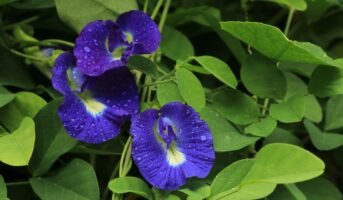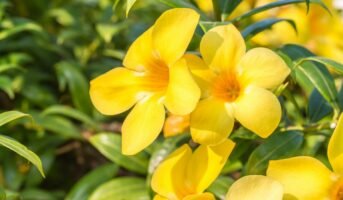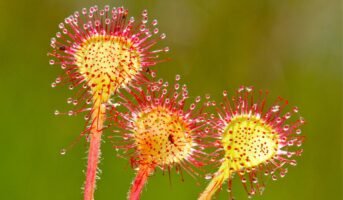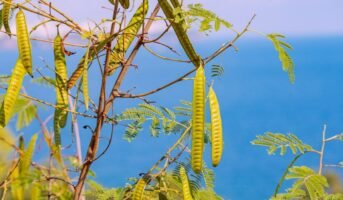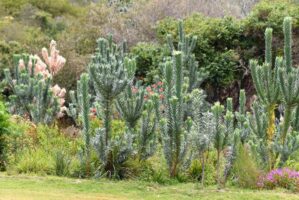Morinda citrifolia, a tree from the coffee family, is a useful, ornamental tree. Morinda citrifolia is a shrub or small tree that has become important worldwide due to the health and cosmetic products made from its leaves and fruits. It is a native of Southeast Asia, Polynesia and Northern Australia.
A tree of the genus Morinda, it can be cultivated and found naturally across tropical and sub-tropical regions of the world. Morinda citrifolia grows in a wide range of environments and soils and has an unusual ability to survive in harsh conditions, such as coral atolls or basaltic lava flows. They can be container-grown or planted as a specimen. The trees begin fruiting at around one year of age. The branches and trunk of Morinda are coarse, tough wood and the leaves are glossy, oval and dark green. Throughout the year, the tree produces a small fruit, which is cream-coloured and the size of a small potato. The morinda, better known as noni fruit, has a bitter taste and unpleasant smell but several healing properties.
See also: Phyllanthus acidus: A plant full of benefits

see all about Katuk
Morinda: Key facts
| Botanical name: Morinda citrifolia
Genus: Morinda Common name: Great Morinda, Indian mulberry, Noni forbidden fruit, Dye tree and Cheese Fruit Native distribution: Australia, India, Southeast Asia, Pacific Native habitat: Terrestrial (Secondary Rainforest, Monsoon Forest, Coastal Forest), Shoreline Plant growth form: Small tree (6-15m) Flower colour: White clusters of tubular flowers Fruits: Lumpy, cream-coloured, oval-shaped fruits Foliage: Glossy and oval-shaped evergreen Climate: Tropical and sub-tropical climates Sunlight: Full sun or partial shade Water: Moderate water Soil: Well-drained, well-aerated soil (can grow in a wide range of soils) Landscape: Small gardens, beachfront and shoreline Plant use: Edible parts, medicinal properties, ornamental |
Morinda types
Morinda is the largest genus of the Rubiaceae family, with 11 species found in India. In India, it is known by several names, such as great morinda, Indian mulberry, noni, beach mulberry and cheese fruit. Morinda is represented by over 80 species, primarily from the old-world tropical regions. The genus name is derived from the Latin morus. Most popular species are Morinda citrifolia, Morinda trimera and Morinda reticulata.
There are two types of Morinda citrifolia – the large noni fruit with oval leaves and the small noni fruit with elongated leaves.


How to care for the Morinda tree?
Morinda’s lush looks and low maintenance needs make it an interesting hedging plant for gardens and patios in warm climates. Provide at least 15-20 feet of space for each tree and avoid planting it close to buildings to prevent root damage.
Sunlight
Morinda can grow in a range of light levels, from full sun to shade. Tropical leaves become big and dark in shade. Low light reduces the number of flowers and fruits.
Water
Regular watering (2-3 times a week) is required during establishment. Later, water only during long periods of drought or in hot, dry weather. In its natural habitat, noni thrives with moderate watering and can survive extended periods of drought, once established and mature. In containers, it prefers moist soil at all times to avoid the wilting of the large, meaty leaves.
Soil and climate
Morinda grows in a range of soils and environments with a notable ability to survive in harsh environments. Noni tree grows well on sandy or rocky shores. Apart from saline conditions, it can withstand drought and grows in poor soil. However, it prefers free, well-drained soils. It can grow in a range of acidity. Noni shrub seldom requires fertiliser and overfeeding makes them more susceptible to pests, such as aphids, scale insects and whiteflies.
Diseases and pests
Morinda trees can be attacked by sap-sucking insects, such as scale and aphids. These can be treated with an eco-oil spray. Take the time to control ants, too, as these increase the likelihood of scale and aphids. Medicinal plants like Morinda usually do not need chemical pesticides. Organic practices include control measures using neem-based formulations. Fish oil resin soap can be used to manage pests.

Propagation of morinda
Morinda can be propagated by seed and stem cuttings. Take seeds from the fruit and soak them in water. Rub to remove the pulp. Once clean, sow on a bed of seed-raising mix and cover lightly. Place over a heat mat and water regularly. When plants have developed their first few leaves, seedlings can be potted and moved to a protected area in partial shade. Once it starts maturing, move it to a position with full sun.
To grow it from a stem cutting, take a cutting of about 25-30cm. Remove the lower half of the leaves by pinching your fingers over the stem and running them down the cutting. Dip the cutting in the rooting hormone and place it in a pot of propagating soil mix. Stem cuttings may root in two days and be ready for transplanting in almost two months. As with plants derived from seeds, rooted stem cuttings may be grown in pots for up to 24 weeks or more with excellent results when transplanted. Morinda tree begins to bear fruit at about 9-12 months after planting.
see also: all about Propagation
What is morinda used for?
- Polynesian healers have used Morinda fruits, which have a pungent odour, for thousands of years to treat various health problems.
- The unripe fruit is used in Indian cooking in sambals and curries.
- Though the smell of the Morinda fruit is like cheese, the ripe fruit is used to make beverages with sugar or syrup.
- The juice is used for dressings, sauces and marinades.
- Morinda is a safe plant with edible fruit. Since ancient times, morinda (noni) juice has been used to treat general weakness.
- It boosts energy and improves overall physical performance.
- Morinda is also known as ‘The Tree for Headaches’ or ‘The Painkiller Tree’ as it is a traditional medicine for reducing
- Morinda citrifolia is used in various green industrial sectors, including juice products, natural preservatives and as a natural source of medicine.
- The Morinda bark gives a reddish-purple and brown dye that is used in batik. A yellowish dye can be extracted from the roots to dye clothes.

Health benefits of morinda
- Morinda citrifolia has been widely used as a complementary and alternative therapy.
- All parts of Morinda citrifolia – leaves, fruits, roots, bark, flowers and seeds – have been used in traditional medicines.
- Many scientific studies mention the fruit’s healing powers.
- The medicinal value of Morinda citrifolia (commonly known as noni) has been explored in ancient remedies with a range of therapeutic utilities, including anti-bacterial, anti-viral, anti-fungal, anti-tumour and analgesic.
- Morinda citrifolia, commonly called Indian mulberry or Achi, is used in Ayurveda.
- The fruit and its juice have been used in the treatment of diabetes, heart troubles and high blood pressure.
- Morinda fruit is rich in Vitamin C and beta-carotene, which is used to enhance immunity.
- It has phytonutrients that help in regulating the digestion process.
- The leaves have been used in remedies for arthritis, digestive problems, parasites and dysentery.
- The juice and fruit powder derivates are applied to soothe irritation and dandruff.
See also: Sauropus androgynus: Katuk edible uses and health benefits


FAQs
Is Morinda the same as noni?
Yes, Morinda citrifolia is the scientific and botanical name of noni (Hawaiian name). The name is originally derived from two Latin words, morus meaning mulberry and indicus implying Indian.
Is Morinda edible?
Morinda fruits are edible but have a strong flavour and unpleasant smell when ripe. At first, it is green and eventually turns yellow and almost white as it ripens. For over 2000 years, South Pacific islanders have consumed noni fruits.
What is noni fruit called in English?
Morinda is today hailed as a tropical superfood. The oval-shaped, greenish-yellow fruit has a pungent odour and bitter taste, thus, it is called cheese fruit. It is also commonly known as Indian mulberry, great morinda and beach mulberry.
What are Morinda lucida and Morinda tinctoria?
Morinda lucida, also referred to as the brimstone tree, is an ethnomedicinal plant that has been widely used in traditional medicine in the African continent. Morinda tinctoria, commonly known as aal or Indian mulberry, is a flowering species of the plant and is native to southern Asia.
Purnima Goswami Sharma is a freelance writer based in Mumbai, who has been contributing to various newspapers, magazines and portals for the last two decades. Besides being a research writer for various TV shows, she has been a visiting faculty at SNDT for Communication Skills. She hold a master’s degree in English Literature from Mumbai University and a diploma in Communications and Journalism. She writes on diverse subjects like real estate, interiors, education, lifestyle, health, entertainment and environment.
Email: [email protected]


